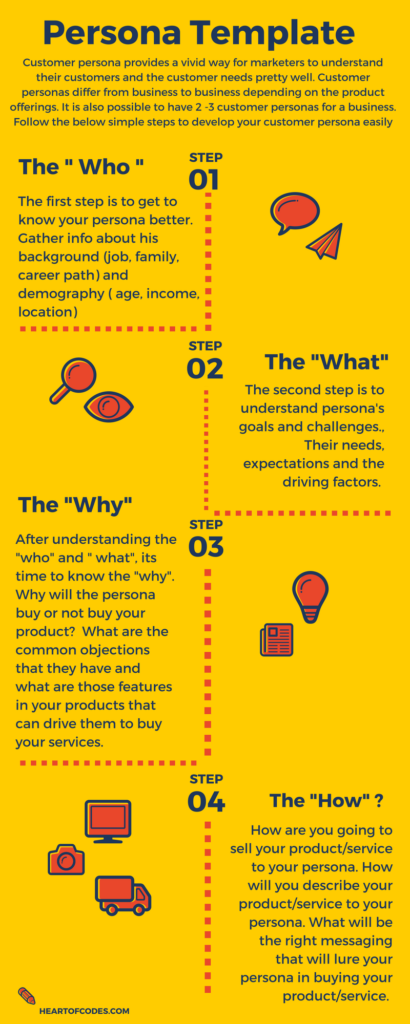The customer is the king
For any brand or for any business to be successful, it’s imperative for them to know who their customer is, what are their likes, dislikes and so on.
And this is where Buyer or customer persona comes into the picture.
So, what is Customer Persona?
Customer or Buyer persona is a semi-fictional representation of your ideal average customer covering demographic details, behavior patterns, gender, socioeconomic status etc. All this information is sourced out of the actual research done about your existing target customer.
In the time when customer experience has become one of the biggest deciding factors in deciding customer loyalty. It’s this customer persona that lets you understand your customer better and turn their loyalty towards your brand.
A look at the 2018 customer engagement and loyalty stats lets you understand as to what is being liked by the customers nowadays.
- 80% of consumers indicated they are more likely to do business with a company if it offers personalized experiences
- Consumers who believe personalized experiences are very appealing are 10x more likely to be a brand’s most valuable customer – those expected to make more than 15 transactions in one year
- Consumers who believe companies are doing very well on offering personalized experiences shop more than three times more frequently
- 22% of consumers would leave for other brands after a creepy experience
Importance of developing a customer or buyer persona – Why do you need them
Having a customer or buyer persona plays a very crucial role in your marketing business plan. Having customer personas help you in :
Read more on to understand the importance of a marketing plan and marketing objectives in achieving business goals
Defining your audience: Customer persona’s help you segment your target audience. Well think about it: You will not have one set of target audience and you will also not be marketing to the whole wide world. Customer persona’s let you filter out audiences that you want to really focus on, create strategies to reach out to them and create different types of content for a different target audience.
Connecting with customers: Let’s say your company is selling recruitment software’s, one of the target buyers will be recruitment consultants as well (main buyers will be HR’s of the company).So, the traditional approach of selling recruitment solutions to recruitment consultants will be creating sales brochures/content pieces that will allow your sales team to explain them about the benefits of your product. This is just one and a small part of the marketing strategy
Customer persona will let you explore different other ways of reaching out to your customer. For example: Creating blog posts, whitepapers, infographics that answers the questions and challenges that your buyer has is one other and different way to reach out to the recruitment consultants.
Developing relevant content: The same content cannot be catered to different target audiences. One needs to have a set content strategy for targetting different customer segments. Each target audience has their own set of purchase drivers & factors. Customer persona lets you understand these purchase drives which ultimately allows you to create or modify your content pieces for different target audiences, covering pain points which are specific to that particular audience.
Defining your promotional strategy- The 4P’s of marketing: For example: For customers of age group 50+ – It would not be a good idea to choose social media as a medium of promotion.Customer or buyer persona gives you deep insights about your target audience, about their pain points, where they spend most of their time and what and what channels they trust the most to gather information.
How to develop customer or buyer persona
While developing a customer persona is a time-consuming task, they are surely highly effective and can help businesses in not only forming their marketing campaigns but also help them in developing their future business strategies.
A customer persona is created through past customer data, surveys, research and interviews of target audience.Schedule focused group discussions and interviews with your target audience and get to know the following information about them
- Who they are
- Their future goals
- How they think
- Factors that drive their behavior change
- How they buy
- Factors that influence their buying decision
- Where they buy
- When they buy
More refined the information the better it is in developing the customer persona.
Your sales team is your foremost source of information: Your sales team is the first one to interact with the customers and knows your customer more than anybody in your company.Connect with your sales team and take their help in developing customer personas, what your personas like, what are their goals and challenges etc.
Developing Customer Persona Template
Below is a 4-step infographic explaining customer persona template
The “Who”: Gather the most basic information about your persona, his job, age, income etc.
The “What”: Understand the goals and challenges of your personas, their needs and their buying drivers.
The “Why”: Get to know why will your persona buy your product/service, what is that one driving factor that you have and your competition doesn’t. Why will your person choose you over your competition?
The “How”: Once you have figured out the question to the above 3 main questions, it’s time to find out the way on how to approach your persona. What type of messaging will be most appropriate for them? What will be the best mediums to reach out to your persona’s and how frequently the messaging should be sent out to different personas.
Also, read about what is brand identity and its importance in marketing
Read more about marketing business plan and the importance of marketing plan in achieving business objectives.
